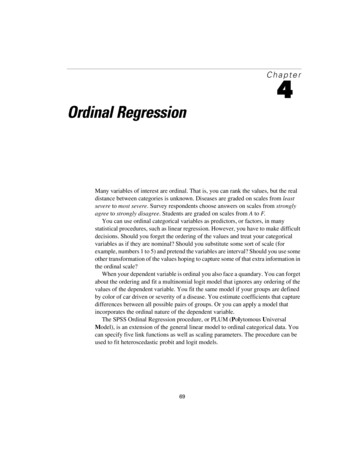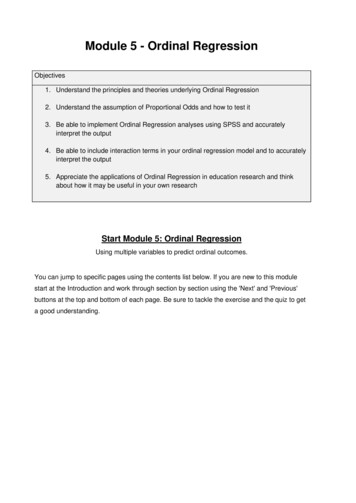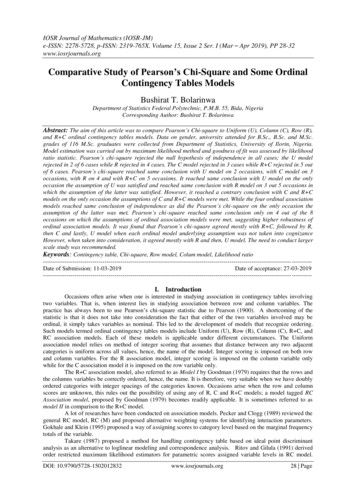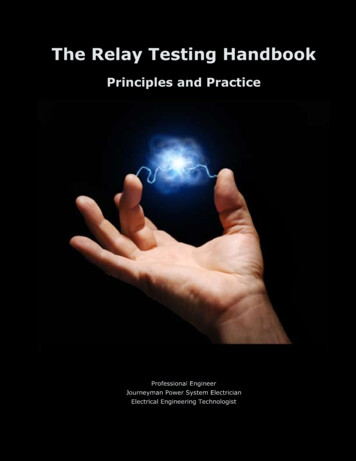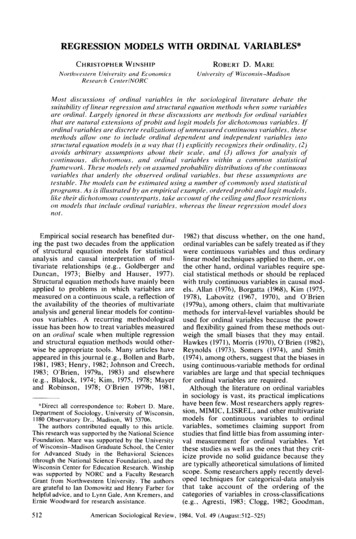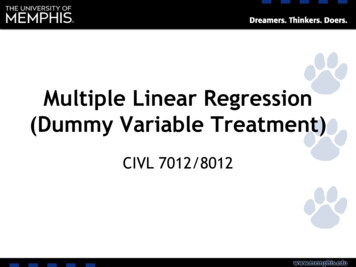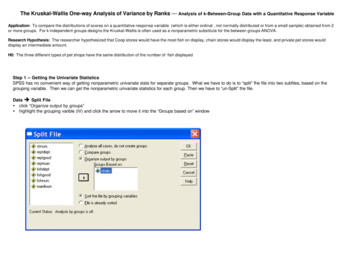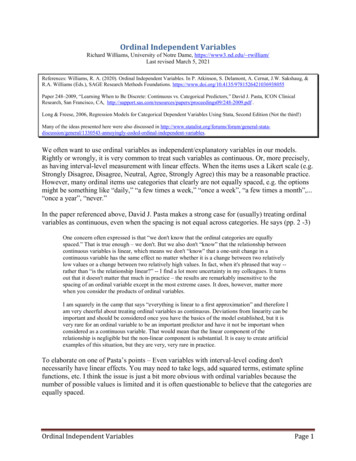
Transcription
Ordinal Independent VariablesRichard Williams, University of Notre Dame, https://www3.nd.edu/ rwilliam/Last revised March 5, 2021References: Williams, R. A. (2020). Ordinal Independent Variables. In P. Atkinson, S. Delamont, A. Cernat, J.W. Sakshaug, &R.A. Williams (Eds.), SAGE Research Methods Foundations. er 248–2009, “Learning When to Be Discrete: Continuous vs. Categorical Predictors,” David J. Pasta, ICON ClinicalResearch, San Francisco, CA, s09/248-2009.pdf .Long & Freese, 2006, Regression Models for Categorical Dependent Variables Using Stata, Second Edition (Not the third!)Many of the ideas presented here were also discussed in al-independent-variables.We often want to use ordinal variables as independent/explanatory variables in our models.Rightly or wrongly, it is very common to treat such variables as continuous. Or, more precisely,as having interval-level measurement with linear effects. When the items uses a Likert scale (e.g.Strongly Disagree, Disagree, Neutral, Agree, Strongly Agree) this may be a reasonable practice.However, many ordinal items use categories that clearly are not equally spaced, e.g. the optionsmight be something like “daily,” “a few times a week,” “once a week”, “a few times a month”,.“once a year”, “never.”In the paper referenced above, David J. Pasta makes a strong case for (usually) treating ordinalvariables as continuous, even when the spacing is not equal across categories. He says (pp. 2 -3)One concern often expressed is that “we don't know that the ordinal categories are equallyspaced.” That is true enough – we don't. But we also don't “know” that the relationship betweencontinuous variables is linear, which means we don't “know” that a one-unit change in acontinuous variable has the same effect no matter whether it is a change between two relativelylow values or a change between two relatively high values. In fact, when it's phrased that way -rather than “is the relationship linear?” -- I find a lot more uncertainty in my colleagues. It turnsout that it doesn't matter that much in practice – the results are remarkably insensitive to thespacing of an ordinal variable except in the most extreme cases. It does, however, matter morewhen you consider the products of ordinal variables.I am squarely in the camp that says “everything is linear to a first approximation” and therefore Iam very cheerful about treating ordinal variables as continuous. Deviations from linearity can beimportant and should be considered once you have the basics of the model established, but it isvery rare for an ordinal variable to be an important predictor and have it not be important whenconsidered as a continuous variable. That would mean that the linear component of therelationship is negligible but the non-linear component is substantial. It is easy to create artificialexamples of this situation, but they are very, very rare in practice.To elaborate on one of Pasta’s points – Even variables with interval-level coding don'tnecessarily have linear effects. You may need to take logs, add squared terms, estimate splinefunctions, etc. I think the issue is just a bit more obvious with ordinal variables because thenumber of possible values is limited and it is often questionable to believe that the categories areequally spaced.Ordinal Independent VariablesPage 1
Long and Freese (in the 2006 edition of their book) agree that ordinal variables are often treatedas continuous. But they add (p. 421) thatThe advantage of this approach is that interpretation is simpler, but to take advantage of thissimplicity you must make the strong assumption that successive categories of the ordinalindependent variable are equally spaced. For example, it implies that an increase from nopublications by the mentor to a few publications involves an increase of the same amount ofproductivity as an increase from a few to some, from some to many, and from many to lots ofpublications. Accordingly, before treating an ordinal independent variable as if it were interval,you should test whether this leads to a loss of formation about the association between theindependent and dependent variable.In short, it will often be ok to treat an ordinal variable as though it had linear effects. The greaterparsimony that results from doing so may be enough to offset any disadvantages that result. But,there are ways to formally test whether the assumption of linearity is justified.Likelihood Ratio Chi-Square Test and/or BIC tests. Here, you estimate two models. In theconstrained model the ordinal variable is treated as continuous, in the unconstrained model it istreated as categorical. You then use an LR chi-square test (or a BIC test or AIC test) to decidewhether use of the more parsimonious continuous measure is justified. webuse nhanes2f, clear. * Treat health as continuous. logit diabetes c.health, nologLogistic regressionLog likelihood -1784.9973Number of obsLR chi2(1)Prob chi2Pseudo R2 -diabetes Coef.Std. Err.zP z [95% Conf. Interval]------------- -------------health -.8128706.0421577-19.280.000-.8954982-.730243cons ---------------------. est store m1. * Now treat health as categorical. logit diabetes i.health, nologLogistic regressionLog likelihood -1784.1984Number of obsLR chi2(4)Prob chi2Pseudo R2 -diabetes Coef.Std. Err.zP z [95% Conf. Interval]------------- -------------health fair ge -1.567205.1302544-12.030.000-1.822499-1.311911good llent -3.116457.2262238-13.780.000-3.559848-2.673067 Ordinal Independent VariablesPage 2
cons ----------------------. est store m2. * Now do LR/ BIC/ AIC tests. lrtest m1 m2, statsLikelihood-ratio test(Assumption: m1 nested in m2)LR chi2(3) Prob chi2 1.600.6599Akaike's information criterion and Bayesian information -----------------------------------Model Obs ll(null) ll(model)dfAICBIC------------- ------------m1 10,335 -1999.067 -1784.99723573.9953588.481m2 10,335 -1999.067 --Note: N Obs used in calculating BIC; see [R] BIC note.A visual inspection of the coefficients from the 2nd model indeed suggests that the effects ofhealth are continuous, i.e. each coefficient is about .75 greater than the coefficient before it. TheLR/ BIC/ AIC tests also all agree that the more parsimonious model that treats health as acontinuous variable is preferable.Wald tests. Of course, you can’t always do LR tests. Luckily, Wald tests are also possible. Oneway to do this is by including both the continuous and categorical versions of the ordinal variablein the analysis. If the effects of the categorical variable are not statistically significant, then thecontinuous version alone is sufficient. Note that, because we are including two versions of theordinal variable, two categories of the ordinal variable must be excluded rather than the usualone. We can do this via use of the o. notation (o stands for omitted). * Wald test. logit diabetes c.health o(1 2).health, nologLogistic regressionLog likelihood -1784.1984Number of obsLR chi2(4)Prob chi2Pseudo R2 -diabetes Coef.Std. Err.zP z [95% Conf. Interval]------------- -------------health -.7493387.1262017-5.940.000-.9966895-.5019878 health fair 0 (omitted)average -.0685278.2104996-0.330.745-.4810995.3440439good ent -.1191024.4829907-0.250.805-1.065747.8275419 cons -----------------------Ordinal Independent VariablesPage 3
. testparm i.health( 1)( 2)( 3)[diabetes]3.health 0[diabetes]4.health 0[diabetes]5.health 0chi2( 3) Prob chi2 1.560.6689Again, the results indicate that the continuous version of the variable is fine.Other options. Other strategies for dealing with ordinal independent variables have beenproposed. In the Statalist thread linked to above, Ben Earnhart notes that a common, if notnecessarily correct approach, is to code the midpoint of categories, e.g.“daily” 1“once a week” 1/7“a few times a month” (1/7)*(3/4)“once a year” 1/365.25“never” 0Of course, some categories may be open-ended (e.g. 100,000 or more) which can make thisstrategy problematic.Maarten Buis (same thread) also suggests that the sheafcoef command (available from SSC)can be used. The help file for sheafcoef sayssheafcoef is a post-estimation command that estimates sheaf coefficients (Heise 1972). A sheafcoefficient assumes that a block of variables influence the dependent variable through a latentvariable. sheafcoef displays the effect of the latent variable and the effect of the observed variableson the latent variable. The scale of the latent variable is identified by setting the standard deviationequal to one. The origin of the latent variable is identified by setting it to zero when all observedvariables in its block are equal to zero. This means that the mean of the latent variable is not(necessarily) equal to zero. The final identifying assumption is that the effect of the latent variableis always positive, so to give a substantive interpretation of the direction of the effect, one needs tolook at the effects of the observed variables on the latent variable. Alternatively, one can specifyone “key” variable in each block of variables, which identifies the direction of a latent variable,either by specifying that the latent variable has a high value when the key variable has a high valueor that the latent variable has a low value when the key variable has a high value.The assumption that the effect of a block of variables occurs through a latent variable is not atestable constraint; it is just a different way of presenting the results from the original model. Itsmain usefulness is in comparing the relative strength of the influence of several blocks ofvariables. For example, say we want to know what determines the probability of working nonstandard hours and we have a block of variables representing characteristics of the job and anotherblock of variables representing the family situation of the respondent, and we want to saysomething about the relative importance of job characteristics versus family situation. In that caseone could estimate a logit model with both blocks of variables and optionally some other controlvariables. After that one can use sheafcoef to display the effects of two latent variables, familybackground and job characteristics, which are both standardized to have a standard deviation of 1,and can thus be more easily compared.The output is divided into a number of equations. The top equation, labeled “main”, represents theeffects of the latent variables and other control variables (if any) on the dependent variable. TheOrdinal Independent VariablesPage 4
names of the latent variables are as specified in the latent() option. If no names are specified, theywill be called “lvar1”, “lvar2”, etc. Below the main equation, one additional equation for everylatent variable is displayed, labelled “on name1”, “on name2”, etc., where “name1” and “name2”are the names of the latent variables. These are the effects of the observed variables on the latentvariable.The sheaf coeficients and the variance covariance matrix of all the coefficients are estimated usingnlcom. sheafcoef can be used after any regular estimation command (that is, a command thatleaves its results behind in e(b) and e(V)), The only constraint is that the observed variables thatmake up the latent variable(s) must all come from the same equation.Here is an example. As far as I know, sheafcoef does not support factor variables, so we haveto compute the dummies ourselves. * sheaf coefficients. tab health, gen(hlth)1 poor,., 5 excellent Freq.PercentCum.------------ ----------------------------------poor 7297.057.05fair 1,67016.1623.21average 2,93828.4351.64good 2,59125.0776.71excellent 2,40723.29100.00------------ ----------------------------------Total 10,335100.00. logit diabetes hlth2 hlth3 hlth4 hlth5, nologLogistic regressionLog likelihood -1784.1984Number of obsLR chi2(4)Prob chi2Pseudo R2 -diabetes Coef.Std. Err.zP z [95% Conf. Interval]------------- -------------hlth2 -.7493387.1262017-5.940.000-.9966895-.5019878hlth3 4 5 -3.116457.2262238-13.780.000-3.559848-2.673067cons ----------------------. sheafcoef, latent(hlth: hlth2 hlth3 hlth4 ---------------------------------diabetes Coef.Std. Err.zP z [95% Conf. Interval]------------- -------------main hlth .9751702.066869414.580.000.84410851.106232cons -------- -------------on hlth hlth2 -.7684183.1401325-5.480.000-1.043073-.4937637hlth3 -1.607109.1688974-9.520.000-1.938142-1.276077hlth4 5 ---------------------Ordinal Independent VariablesPage 5
In short, the main equation tells us how the underlying latent variable hlth affects the dependentvariable diabetes. The on hlth equation shows you how the observed hlth dummies affect thelatent variable hlth. You don’t need to assume that the categories are equally spaced.Here is another example. In this case the LR test says we should NOT treat the ordinal variableagegrp as continuous. Visual inspection of the coefficients in the model that treats agegrp ascategorical also suggests that it may not be correct to treat the effects of the variable as linear.However the BIC test disagrees, so a reasonable case could be made for going with the moreparsimonious model. * Another example: agegrp. logit diabetes c.agegrp, nologLogistic regressionLog likelihood -1835.5776Number of obsLR chi2(1)Prob chi2Pseudo R2 -diabetes Coef.Std. Err.zP z [95% Conf. Interval]------------- -------------agegrp .5533155.035069115.780.000.4845813.6220497cons -----------------------. est store m1. logit diabetes i.agegrp, nologLogistic regressionLog likelihood -1830.4836Number of obsLR chi2(5)Prob chi2Pseudo R2 -diabetes Coef.Std. Err.zP z [95% Conf. Interval]------------- -------------agegrp age30-39 .7021745.33962472.070.039.03652231.367827age40-49 1.660128.30286145.480.0001.066532.253725age50-59 2.207308.28602647.720.0001.6467062.767909age60-69 2.63842.26774019.850.0002.1136593.16318age 70 2.971236.277945510.690.0002.4264723.515999 cons ----------------------. est store m2. lrtest m1 m2, statsLikelihood-ratio test(Assumption: m1 nested in m2)LR chi2(4) Prob chi2 10.190.0374Akaike's information criterion and Bayesian information -----------------------------------Model Obs ll(null) ll(model)dfAICBIC------------- ------------m1 10,335 -1999.067 -1835.57823675.1553689.642m2 10,335 -1999.067 ---Ordinal Independent VariablesPage 6
Note: N Obs used in calculating BIC; see [R] BIC note.Using sheafcoef,. * Sheaf coefficients for agegrp. tab agegrp, gen(xage)Age groups 1-6 Freq.PercentCum.------------ ----------------------------------age20-29 2,32022.4422.44age30-39 1,62115.6838.13age40-49 1,27012.2950.41age50-59 1,28912.4762.88age60-69 2,85227.5990.47age 70 9859.53100.00------------ ----------------------------------Total 10,337100.00. logit diabetes xage2 xage3 xage4 xage5 xage6, nologLogistic regressionLog likelihood -1830.4836Number of obsLR chi2(5)Prob chi2Pseudo R2 -diabetes Coef.Std. Err.zP z [95% Conf. Interval]------------- -------------xage2 .7021745.33962472.070.039.03652231.367827xage3 1.660128.30286145.480.0001.066532.253725xage4 2.207308.28602647.720.0001.6467062.767909xage5 2.63842.26774019.850.0002.1136593.16318xage6 2.971236.277945510.690.0002.4264723.515999cons ----------------------. sheafcoef, latent(age: xage2 xage3 xage4 xage5 ---------------------------------diabetes Coef.Std. Err.zP z [95% Conf. Interval]------------- -------------main age 1.106507.091518112.090.000.92713441.285879cons -------- -------------on age xage2 .6345868.28415022.230.026.07766271.191511xage3 1.500333.19108897.850.0001.1258051.87486xage4 1.994844.140572814.190.0001.7193262.270362xage5 2.384459.089169226.740.0002.2096912.559227xage6 -------------------In short, with sheafcoef, we potentially get the advantages of treating an ordinal variable ascontinuous, without actually having to assume that categories are equally spaced. Whether it isworth the trouble is another matter; you can judge based on the circumstances. It may depend onwhat the tests of linear effects say or how reasonable it is to treat a variable as continuous basedon its coding.Ordinal Independent VariablesPage 7
names of the latent variables are as specified in the latent() option. If no names are specified, they will be called "lvar1", "lvar2", etc. Below the main equation, one additional equation for every latent variable is displayed, labelled "on_name1", "on_name2", etc., where "name1" and "name2"
